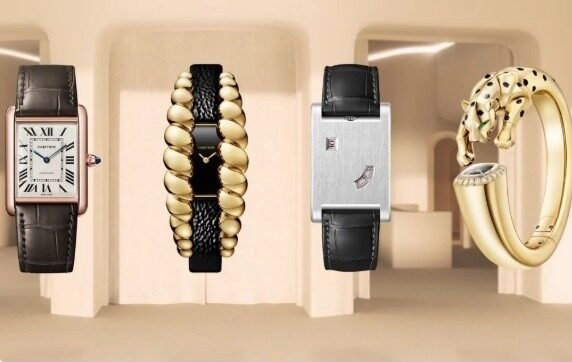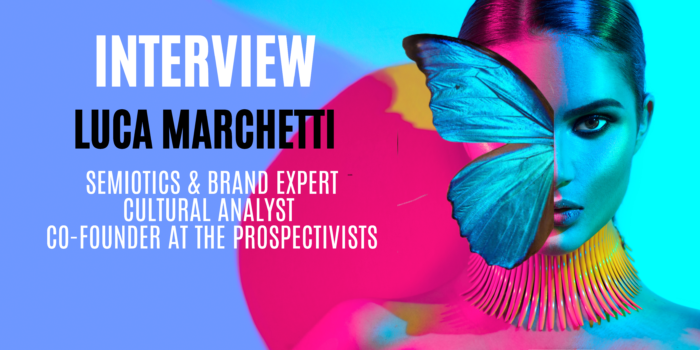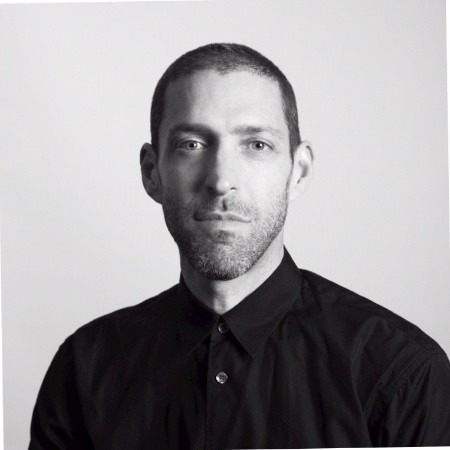

Today we spoke with Luca Marchetti, an expert semiotician, who gives a new perspective behind semiotics in fashion, luxury and cosmetics and challenges the classical way of thinking about branding and the metaverse!

Luca Marchetti Semiotics & Brand Expert, Cultural Analyst co-founder at THE PROSPECTIVISTS
Betty Karastatira for Geneva Business News: Luca, tell us about you and your expertise behind brand semiotics.
Luca Marchetti: I was trained in Bologna in the Communication and Semiotics Department, directed by Umberto Eco. He is more well known as an author, yet he was an eminent Semiotician studying at a time when all these things like design semiotics were strange. I started being interested in Fashion and Design and although I am Italian, Milan but also Paris were not the places to observe fashion interestingly.
At that time, London was the best place to study fashion codes directly on the street. There was so much to learn about the way to tell stories about the different trends. Today it is another world, then it was another century! Fashion in Milan was very official and glamorous at the time, while in London you could produce your clothes from plastic bags and you were cool!
Today my work for brands is much more complex than deciphering “fashion signs” in the street.
I work both on cultural semiotics projects and curatorial ones – such as exhibitions, books, and art events. I also co-founded a foresight and innovation studio with three associates. We work in and out of fashion, from perfumes and cosmetics up to urbanism and mobility, with an approach based on the analysis of “Weak Signals”.
GBN: What is a Weak Signal?
Luca: The Weak Signal is a cultural or social phenomenon, shared by very “early adopters.” It is scarcely visible and too weak to be easily recognizable in the market. But it is liable to acquire importance and semantic potential. It helps to understand what will be important by looking at who adopts this code and for what purpose.
GBN: Could you give an example of a Weak Signal?
Luca: Ten years back young people in underground clubs in Paris, London or New York were revamping lycra suits from the 80s. What seemed to me over-coloured pajamas then became a major style trend, ranging from fashion runaways to mass market labels. Yet, when you see that emerging stylists or emerging journalists report a similar phenomenon, in order to understand it, you start looking at the actors of the “tipping point”. This is when something moves from “kind of nothing” to something meaningful for larger communities of people.
GBN: So, are semiotics used to understand future trends in fashion?
Lucas: Yes. It helps analyze potentially “anything” — even banal phenomena. For example, we live in an era of “coolness” and comfort. Everything coming from the leisurable aspect is becoming more aspirational, for the elites as well. But of course, every time a trend is established there is a countertrend developing at the same time, not exactly the opposite trend, but a trend addressing the same need but driving in an alternative direction.
This is normal and it was observed already more than one century back; as an unstable balance between imitation and differentiation.
Once a trend is growing and you see early adopters imitating this trend, at the same time, you see a counter-trend growing differently from the initial one.
Differentiation is “I am not everyone, I am a single person, I differentiate myself from the rest.” So, when you are an opinion leader you start being imitated and a new trend arises, a different trend also arises with new opinion leaders and this creates cycles!
GBN: Do you apply semiotics in Brand Building?
Lucas: Yes. I do a semiotic analysis when a brand wants to understand how it scores using benchmarked competition in terms of branding, connection, and codes used to express a common benefit.
Just to give you a banal example, DIOR and CHANEL both promise “light” in cosmetics and skincare, but the radiance is not the same color for them. The quality of lighting and its significance is different. DIOR is closer to the sun; Chanel is closer to the moon! DIOR is a golden brand; Chanel is a silver one. So, semiotics can help create holistic and consistent brand communication deconstructing or building semiotic codes transversal to all brand expressions. You can personify a brand in a simple and self-explaining way to make it more relevant and clearer to the brand-building and communication teams.
GBN: What I love is the fact that semiotics gives brand assets above functional benefits, which is what luxury brands offer. Not just a good functional benefit, but… the dream that justifies a premium price.
Lucas: This is true. What I find even more interesting is also the learnings it can provide for cosmetics and skincare communication. The level of scientific research in these fields is so complex, that if you explain it logically, you lose your audience. Brands then need powerful storytelling to deliver a powerful concept without going into details that consumers will not understand or appreciate, such as chemical reactions, and physiological processes.
Another extremely interesting field I work in Switzerland is the watch Industry. Again, in this industry mechanisms are so sophisticated that you cannot tell the “truth” about them. You need to elevate the benefit beyond them, and beyond time measurement if you want to keep the level of inspiration as high as you need.
For watches, time is not really an issue anymore, not really an aspirational value… maybe because time is not money anymore! Influence is money, and so visibility and “aura”, but not time!
GBN: As a brand builder and a consumer researcher I was trained to talk about the category prototypical benefit and you talk beyond it! This is very innovative, because you say the least about the functional benefit, but you promise more using semiotics!
Lucas: Yes. Once again, about watches, you need to push forward something more than just time accuracy. Today all watches are pretty accurate. So, customers intuitively expect something more…beyond time. Tell that it is handmade but accurate like a digital watch, for example, linked with heritage, and talk about unparalleled craftsmanship and artisanship that makes it unique.
GBN: What about fashion digital trends, such as the metaverse? Do you find semiotics relevant in this field too?
Luca: This field is growing, it will become more and more interesting, which does not mean that I see interesting things now. I cannot think of a brand that has really understood how to transform the metaverse into a powerful tool adding value to their offer for the consumer. Yet, there is something extremely interesting related to the representation of identities related to all the debates and the concerns rising behind inclusivity, #MeToo and how the brands can use the medium to build equity, based on what the users are looking for and feel about themselves.
I am talking about the freedom of self-representation. Audiences are specific but also different, they do not do the same when reading a magazine, when on Facebook, on Instagram, or in the metaverse.
Consumers or users expect to have different experiences from every channel, the semiotic codes are different, and they can build different profiles and different media-specific identities. The brands need to understand this, it is not enough to use the same codes and communication in the metaverse environment.
Brands need to nurture their equity and give different rewarding experiences across mediums as well as metaverse. We cannot always play with the same codes, often we need to disrupt codes. The potential is there, but we need to take risks and adapt to new codes, hence creating new semiotics in the metaverse!
I would like to thank LUCA MARCHETTI for the time dedicated to this interview and the very innovative insights behind semiotics that will definitely inspire industry experts in fashion, luxury, cosmetics and not only!
Stay tuned for more Fashion Butterfly inspirational flights!
By the same author:
The Fashion Butterfly: Babak Daghigh, Founder & CEO of MYPRIVATEDRESSING
The Fashion Butterfly: The second-hand fashion trend & Shopper